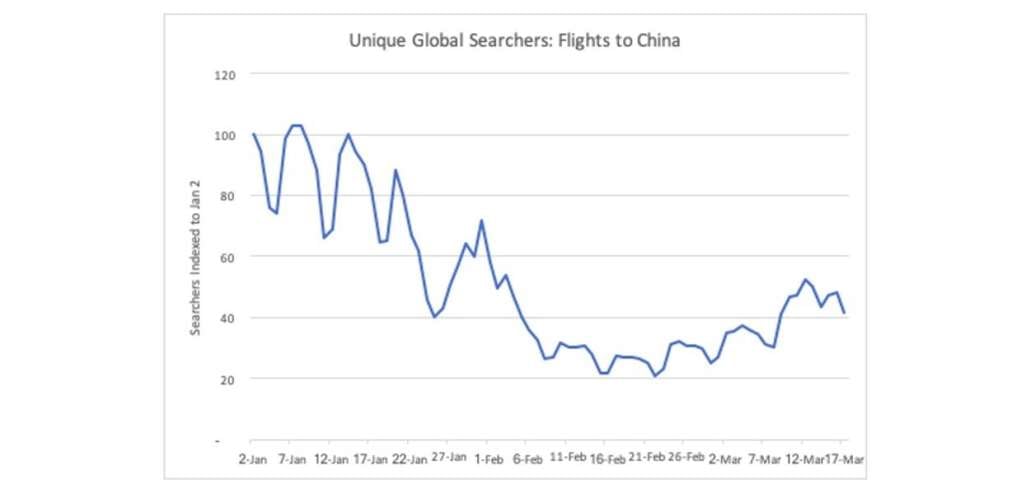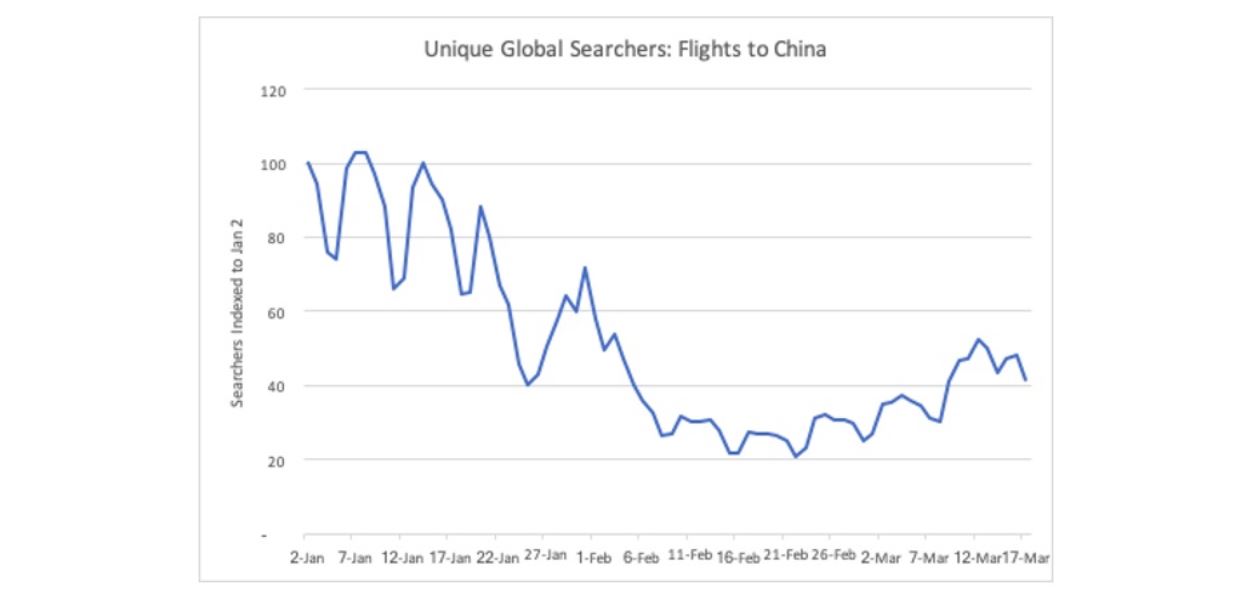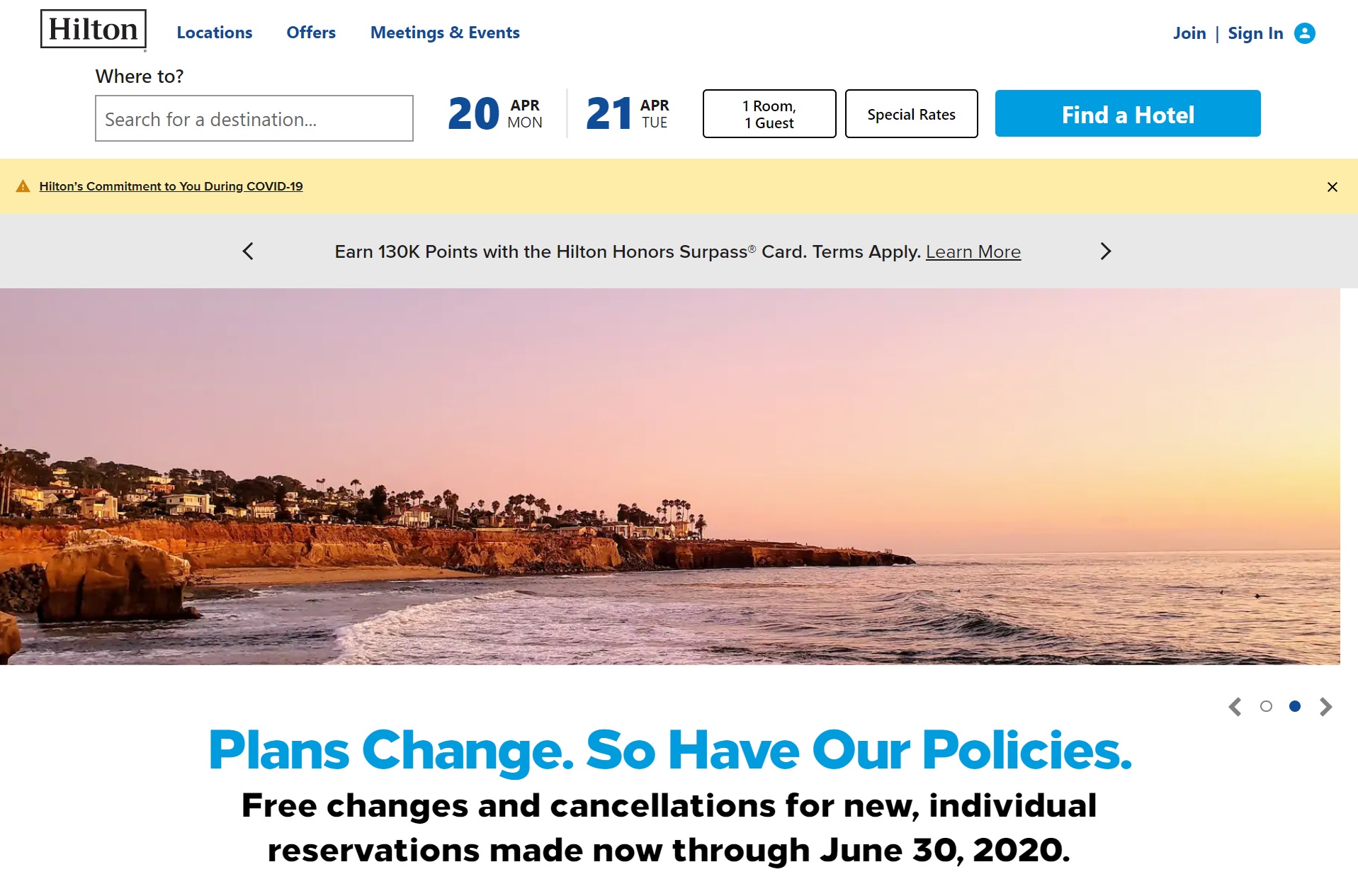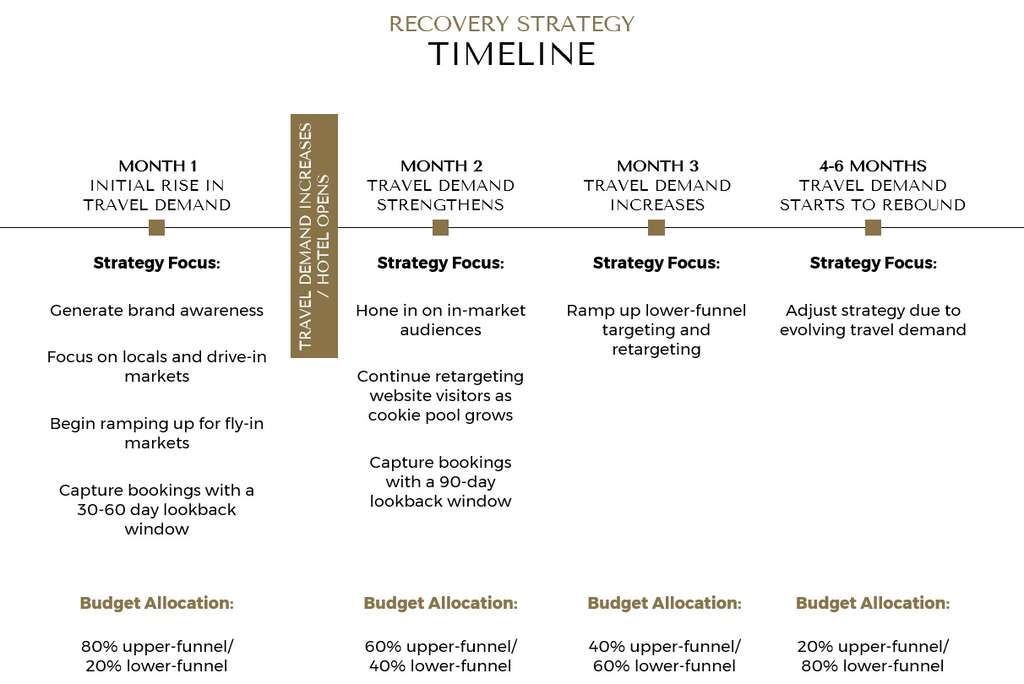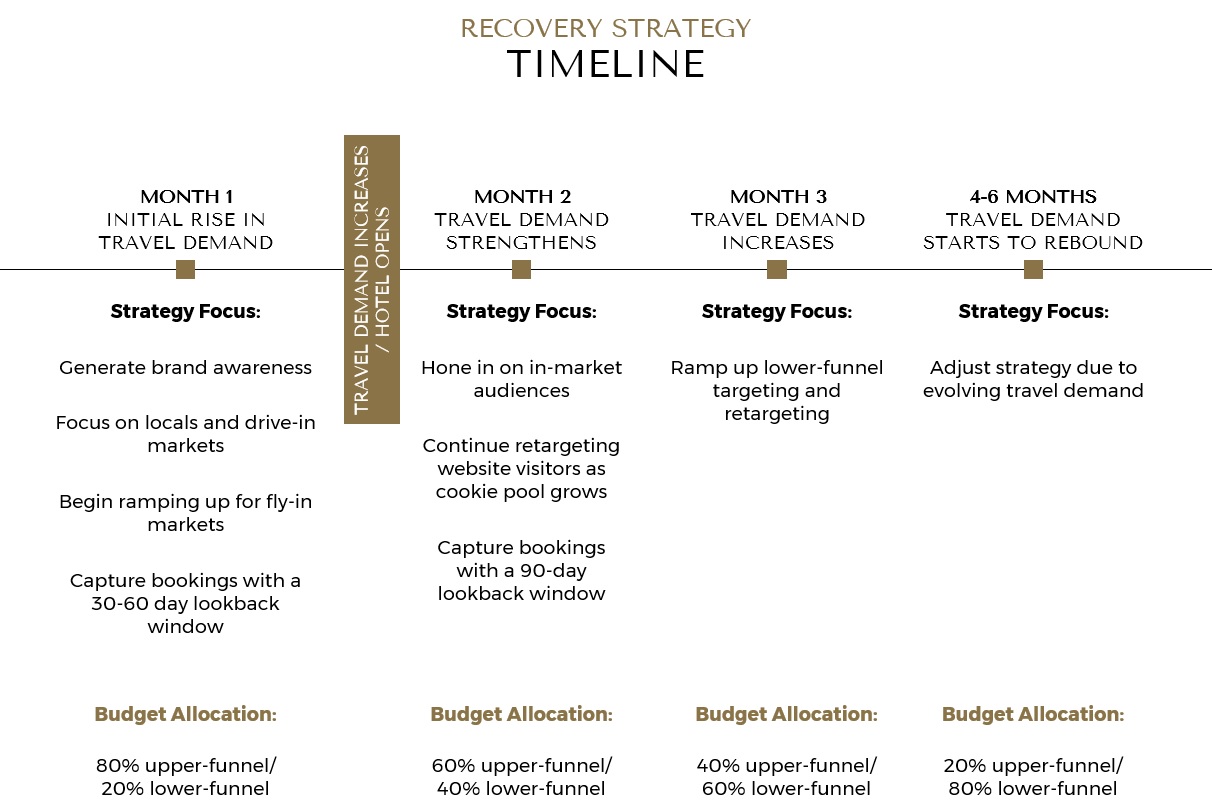COVID-19 Hotel Recovery Strategy: Top 10 Ways to Prepare your Hotel for the Rebound in Travel Demand

As Coronavirus (COVID-19) continues to impact travel globally, it is important to observe industry forecasts and trends that will ultimately shape your recovery strategy as hotels begin to plan for the initial rebound in travel demand.
According to a special forecast from STR and Tourism Economics, due to the COVID-19 outbreak, the hotel industry is projected to report significant declines across demand, occupancy, ADR, and revenue per available room (RevPAR) in 2020. While travel has come to a virtual standstill due to the COVID-19 outbreak, the market is expected to regain its footing in the latter part of the year and next year.
Based on research from CBRE, from the start of the US outbreak in January 2020, it is predicted that it will take approximately 6-10 months (June) for US hotel demand to begin to recover, and 12-16 months for ADR and RevPAR to recover. Therefore, hoteliers need to take the necessary steps to adequately prepare for recovery, while also setting proper expectations and KPIs.
Overall, your hotel should consider a three-phased approach:
- While Travel is on Pause: While people are not traveling and many hotels are closed, hotels should stay connected with past and future guests through social, email, and editorial content that entertains and adds value to maintain a strong brand relationship.
- Initial Rise in Travel Demand: Ramp up marketing efforts focused on brand awareness and fueling new guests into the booking funnel with affordable CPCs and CPMs to reach people beginning to daydream about rebooking and planning vacations. Ensure a flexible cancellation policy and sensitive messaging relevant to the situation.
- Travel Demand Strengthens: Continue marketing efforts shifting focus to lower-funnel intent as well as targeting the right demographics and feeder markets with the right messaging and packages.
This is the second article in a three-part series focused on each phase of a hotel's COVID-19 recovery strategy. This article focuses on phase two: how to prepare for the initial rise in travel demand. For the full recovery strategy across phases, download our COVID-19 Hotel Recovery Strategy eBook.
Recovery Phase Two: Initial Rise in Travel Demand
While we continue to strive to flatten the curve around the world, hotels should be proactive in planning for the rebound in travel demand.
As we prepare for travel demand to build, it is important to align your marketing and revenue management strategy, prepare your website, and determine a month-to-month marketing plan that progressively builds with the rise in travel demand over time.
Projecting the Initial Rise in Travel Demand.
While hotels begin preparing for the initial rebound in travel demand, it's important to observe how travel demand spiked in markets that COVID-19 impacted first. According to travel intent data collected by ADARA, unique searches for flights to China (both domestic and international inbound) increased by 29% for the week of March 8th when travel restrictions were lifted in China.
Based on travel data collected by Triptease, the number of cases in South Korea began to stabilize around March 10th, and direct bookings have steadily increased due to an increase in domestic travel. This data suggests that travel demand in the US will increase after social distancing guidelines and travel restrictions are lifted. The initial lift in bookings will likely be largely attributed to domestic travel as people may be hesitant to travel on airplanes. In fact, according to recent data collected by Sojern, 70% of hotel searches are for destinations within a 500-mile radius. This is a 11% increase from last year (59%).
Understanding Travel Consumer Sentiment for Booking Travel.
According to a survey of North American leisure travelers conducted by Fuel Travel, 45% of travelers have cancelled a trip, and 11% of travelers have rescheduled a trip due to the Coronavirus outbreak. However, 59% of travelers still plan to take a vacation in 2020.
This study reveals that while many consumers have cancelled their trips, they have not lost their desire to travel. Hotels have an opportunity to capture future bookings by engaging guests that have cancelled. After COVID-19 subsides, people may also consider new destinations—opening the door for hotels to attract new audiences.
Here are the top 10 considerations to prepare your digital strategy for the initial rise in travel demand:
1. Align your Marketing and Revenue Management Strategy: When developing your recovery plan, it is important to align with revenue management on rate strategy and parity across channels, direct booking perks, any new offers and packages, and most importantly, a flexible cancellation policy.
2. Prepare your Website: Your website should serve as a source of truth for potential guests and allow them to easily find the information they need to make a booking.
Considerations for your website content:
- If the hotel has closed, clearly state that the hotel is open and accepting reservations, groups, spa appointments, etc. Be sure to address cancellation policies.
- Reassure guests that the hotel is still taking proper precautions on property and will continue to do so to ensure the safety of staff and guests.
- Highlight the destination through a blog post, on your area guide, and hero image to show that businesses and attractions are open. Ensure that all destination content on the website is up to date.
- Promote special offers and packages that are tailored to your target audience at this time. Consider highlighting a LOS offer, staycation offer for locals, or a business to leisure package for business travelers.
- Implement website content personalization based on customer segment, feeder market (local vs international), and website pathing behaviors.
3. Implement a Flexible Cancellation Policy: By implementing a flexible cancellation policy, hotels can reassure guests and give them an incentive to book, while combatting OTAs that often make it difficult to cancel. Booking.com and Expedia enforced a "force majeure policy" during March and have been frequently updating their policies. Having a flexible cancellation policy on the hotel website will be critical in ensuring direct bookings.
Overall, if your hotel brand wants to maintain strong brand loyalty and enforce confidence to rebook, your hotel should maintain a flexible, stress-free cancellation policy for at least the next six months or until end of year.
4. Ensure Direct Bookings and a Healthy Distribution Mix: As travel demand starts to pick up and hotels that are closed are preparing to reopen, focusing on shifting distribution to the direct channel is one of the most effective ways to positively impact your bottom line. With 84% of revenue managers saying they plan to shift more distribution to OTAs post COVID-19, it's no secret that OTAs offer quick visibility for hotels. However, maintaining a healthy distribution mix, and proper planning to encourage bookings through the direct website is critical to maximizing profitability.
Considerations for book direct strategies:
- Ensure rate parity and prominently display book direct perks throughout the website.
- Implement a reservation abandonment strategy to recover lost bookings and ensure bookings through the website vs OTAs.
- Remarket website visitors who searched for specific dates in the booking engine.
- Consider an instant rewards feature where visitors can enter their email to unlock exclusive rates and continue to market to potential guests once the email is captured.
- Personalize website content based on customer segments, feeder markets, and website pathing behaviors.
5. Update Digital Assets with Critical Information:
Make a list of all owned digital assets and ensure they are up-to-date with the proper information that will aid guests in booking. For instance, if your hotel closed, update all local listings to indicate that the hotel is open. If you have a TripAdvisor Business Listing, consider posting an announcement that a prevention plan is in place and the hotel is open and ready for reservations. On platforms such as metasearch, utilize call-outs to emphasize a flexible cancellation policy to help ensure bookings during this uncertain time. For more on COVID-19 information to communicate across channels, read the previous article in this series.
6. Prompt Cancelled Reservations to Rebook: Recapturing bookings you've already won is one of the best ways to swiftly increase occupancy. According to a Fuel Travel study, over 50% of respondents have either canceled or rescheduled a trip, with cancellations outpacing rescheduling by 4:1. For reservations that have been cancelled, launch an email campaign prompting cancellations to rebook with an added complimentary bonus or perk to incentivize them to purchase.
7. Focus on Packages and Offers for the Right Feeder Markets and Booking Window: As mentioned in travel forecasts, demand from local feeder markets is expected to pick up before fly-in, and people are being cautious and booking travel 60-90 days out. In light of this hotels should focus on promoting staycations and advanced purchase offers during the initial rise in travel demand.
8. Develop a Marketing Plan that Ramps up with Travel Demand: Strategizing a month-to-month marketing plan that progressively builds with the rise in travel demand over time will allow you to fuel the booking funnel and maximize revenue. If your hotel has closed, your plan should start one month prior to hotel reopening and continue to shift from upper-funnel to lower-funnel targeting month to month. Considerations for your marketing plan:
- Month 1: Focus on upper-funnel targeting, mainly local feeder markets, a 60-90 day booking window, and in-market and affinity audiences with an 80% budget allocation to upper-funnel initiatives. Exclude demographics that are less-likely to travel. Messaging should be sensitive to the times and focus on building awareness that the hotel is open for bookings with enticing experiential and destination content.
- Month 2: Shift to mid/lower-funnel targeting, begin targeting viable fly-in markets and implement website remarketing as the cookie pool grows. Budget allocation should be roughly 60% upper-funnel, 40% lower-funnel. Messaging should focus on hotel USPs and special offers and packages.
- Month 3: Continue honing in on travel intent targeting as travel demand continues to rise and begin upselling ancillary revenue opportunities by remarketing onsite spa and dining to guests who book. Budget allocation should be roughly 30% upper-funnel, 70% lower-funnel. Messaging should focus on packages that increase length of stay, upsell ancillary offerings, and ways to maximize the average booking value.
- Month 4+: Prioritize lower-funnel initiatives and focus on targeting potential guests based on real-time travel intent to your destination. Budget allocation should be roughly 20% upper-funnel, 80% lower-funnel and you should continue to adjust your strategy to reflect shifts in travel demand. Messaging should focus on answering key business needs and typical seasonality as travel demand begins to stabilize.
9. Stay Connected through CRM: Staying connected to past and upcoming guests through email is a great way to not only drive bookings as travel demand increases, but to ease the stress of travel for upcoming guests. Consider the following CRM campaigns:
- Announce the hotel is open for bookings with a special offer or exclusive experience.
- Offer an exclusive package or perks for cancellations to rebook.
- Send pre-stay and in-stay communication assuring guests that a prevention plan is in place while highlighting available spa and dining, room upgrades, and feature fun activities to do in the destination.
- Create an automated marketing campaign for the anniversary of past guests' stay, prompting them to come back and relive the memories.
10. Make your Loyalty Members a Priority: Loyalty means brand trust, and loyalty members who are familiar with your brand are more likely to book during times of uncertainty. Be sure to reward your loyalty members with personalized and exclusive packages and experiences once COVID-19 subsides.
Overall, as we begin to flatten the curve, proactive planning for the rebound in travel demand can help your hotel make up for lost revenue. Travel demand will steadily increase, and your hotel must be ready to take full advantage. For the full recovery strategy, download our COVID-19 Hotel Recovery Strategy eBook.
ABOUT NEXTGUEST
NextGuest provides hoteliers with everything they need to thrive in the digital world, with bespoke technology solutions developed to meet the needs of luxury hotel clients coupled with elegant design capabilities that bring brands to life. We marry the power of data with brand discovery to uncover unique strategies that apply to everything from website design, content marketing, CRM, and more, helping the world's top hotel brands maximize ROI as they acquire, convert, and retain guests throughout the travel planning journey. While each of our services is available on its own, the integrated technologies, marketing, and consulting offerings work together to increase digital engagement and generate revenue for hoteliers, allowing them to focus on what matters most — serving their guests. www.nextguest.com | [email protected]
Margaret Mastrogiacomo
EVP, Strategy
+1 212 782 3764
NextGuest merged with Cendyn
